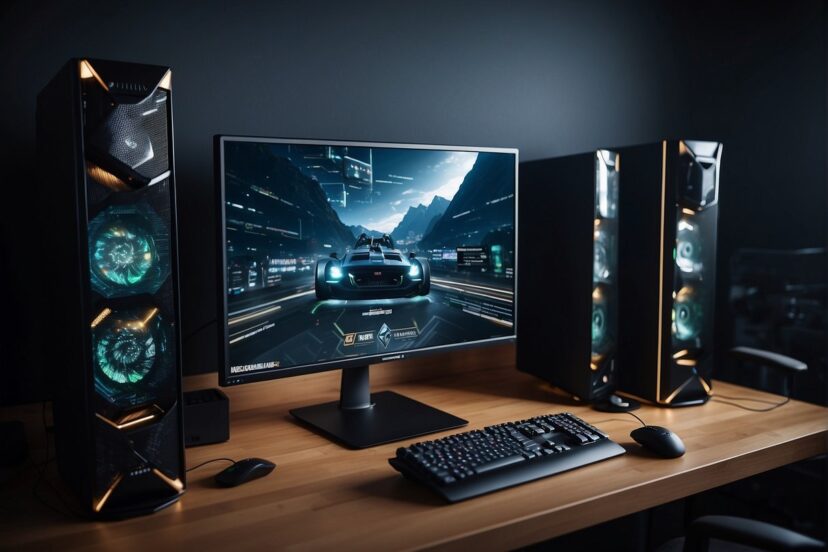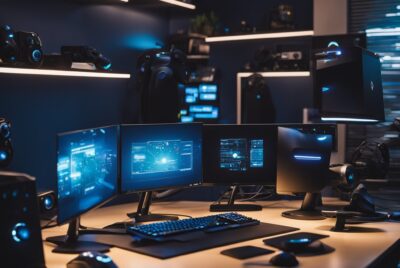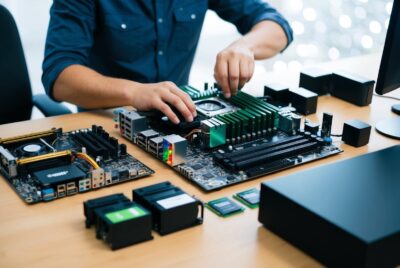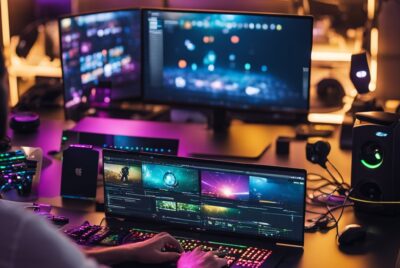Gaming PC with Monitor: The Perfect Setup
*We may earn a commission for purchases made using our links. Please see our disclosure to learn more.
Gaming PC with Monitor: Essential Tips for the Perfect Setup
Investing in the right setup for PC gaming is an important decision for any enthusiast. I understand the importance of both the gaming PC and the monitor as they are central to the experience. The gaming PC itself is the powerhouse that drives the performance, capable of running the latest games at high frame rates, ensuring smooth gameplay, and rendering graphics with precision. In the industry today, there are myriad custom and pre-built options that cater to both budget-friendly and high-end markets. Brands are pushing the envelope with cutting-edge components that include fast processors, robust graphics cards, high-speed memory, and substantial storage solutions.

The monitor, on the other hand, is what brings visual experiences to life. It is the window to the vibrant worlds and stories games have to offer. My understanding of gaming monitors highlights features such as resolution, refresh rates, and panel technology as crucial factors that affect gaming performance and immersion. While 1080p remains a standard resolution, many gamers are moving towards 1440p or 4K for sharper and more detailed imagery. The refresh rate, which indicates how many times a monitor refreshes the displayed image per second, can vary widely. Monitors with higher refresh rates, such as 144Hz or even 240Hz, provide smoother motion, which is key for fast-paced games. Panel technologies like OLED and QD-OLED offer exceptional color and contrast, and are becoming more common in high-end gaming setups.
What’s clear is that the market today offers a plethora of options to customize or select the ideal gaming PC and monitor combination based on individual needs and preferences. Considering the offerings from various retailers, it’s possible to find bundled gaming PCs with monitors or to mix and match different brands and features to suit one’s specific gaming requirements. I keep in mind factors such as ergonomics, adaptive sync technologies like NVIDIA’s G-SYNC or AMD’s FreeSync, and overall aesthetic appeal when making a recommendation, knowing the significance of each in contributing to an enjoyable and immersive gaming environment.
Selecting the Perfect Gaming Monitor

When I choose a gaming monitor, my focus is on the specifications and recent display innovations that elevate gaming experiences. I consider the monitor size and format as well to ensure it fits my gaming setup perfectly.
Understanding Monitor Specifications
What I look for in gaming monitor specifications are the refresh rate, resolution, response time, and panel type. A higher refresh rate, measured in Hertz (Hz), means smoother motion clarity. So, I would opt for monitors with 144Hz, 165Hz, or even 240Hz for competitive gaming where this is crucial. Resolution is another key factor; 1080p is standard, but 1440p or 4K offers significantly sharper images.
For response time, the lower the better to avoid motion blur—ideally 1 ms. The panel technology matters too; TN panels offer fast response times, IPS panels have great color accuracy, while OLED panels provide high contrast ratios and true blacks. If budget is a concern, I seek the Best Budget options without compromising on these core specs.
Innovations in Display Technology
Recent monitor innovations include OLED and QD-OLED panels, which offer superior color contrasts and true black levels. Mini-LED backlights are becoming more common in the Best Gaming Monitor categories, providing excellent HDR performance. Another advancement is Variable Refresh Rate (VRR) technologies like G-Sync and FreeSync that synchronize the monitor’s refresh rate with the GPU’s output, eliminating screen tearing.
I’m always on the lookout for monitors that incorporate these technologies, as they deliver a significantly better visual experience, especially in high-dynamic-range (HDR) content.
Choosing the Right Size and Format
Gaming monitors come in a range of sizes and formats, and choosing depends on personal preference and desk space. For me, a 24-27 inch monitor strikes the right balance between viewing area and detail at typical desk viewing distances.
If I want a more immersive experience, I consider Ultrawide Gaming Monitors or Curved Monitors, which extend the field of view and enhance gaming immersion. A 34-inch ultrawide monitor is ideal for a panoramic view, while maintaining the 21:9 aspect ratio that’s well-supported by many games. I steer clear of oversizing, as too large a display can cause strain and require more head movement.
To sum it all up, I think about the types of games I play, my performance needs, and my desk environment before deciding on the monitor that’s best tailored for my gaming experience.
Building or Upgrading Your Gaming PC

When I consider the process of building or upgrading a gaming PC, I focus primarily on ensuring that key components are high quality and that the system is optimized for peak performance.
Essential Gaming PC Components
The heart of my gaming PC is the Graphics Processing Unit (GPU), which handles the rendering of images and the overall visual performance. Two major players offer top-tier GPUs: NVIDIA and AMD. For those seeking to push high frame rates in games, powerful options include NVIDIA’s RTX series or AMD’s Radeon RX series. A gaming desktop isn’t complete without a robust GPU.
Another critical aspect is the monitor. It needs to match or exceed the GPU’s performance capabilities. I ensure my monitor supports refresh rates that align with the FPS (frames per second) my GPU can output. Technologies like NVIDIA G-Sync or AMD Freesync Premium Pro enhance the gaming experience by synchronizing the refresh rate of the monitor to the frame rate of the GPU, which reduces screen tearing and stuttering.
Optimizing for Performance
To optimize my gaming PC’s performance, I upgrade components that provide significant improvements in speed and efficiency. For example, switching from a 60Hz monitor to a 144Hz or higher refresh rate monitor can reveal the full potential of my GPU, making games look smoother, especially in fast-paced scenarios.
- GPU: Key for rendering and FPS.
- Popular options are NVIDIA’s RTX series or AMD Radeon RX series.
- Monitor: Must support GPU’s power for optimal experience.
- Look for monitors with higher refresh rates and technologies like NVIDIA G-Sync or AMD Freesync.
Finally, I check the compatibility between my selected GPU and monitor. I confirm whether they both support AMD Freesync or NVIDIA G-Sync to match synchronization technologies for a fluid visual performance. This synergy is vital for the immersion and responsiveness I demand from my gaming PC.
Connectivity and Extras

When setting up a gaming PC with a monitor, I focus on the hardware interface and the supplementary features that can enhance the gaming experience. My attention to detail in ports selection and the inclusion of advanced functionalities can make a significant difference in performance and convenience.
Ports and Connectivity Options
The backbone of any PC gaming setup is connectivity. My gaming PC must have a variety of ports to interface with the monitor and peripheral devices:
- HDMI 2.1: For high-resolution and high-refresh-rate displays, HDMI 2.1 is essential. It supports up to 4K resolution at 120Hz or 8K at 60Hz, which is beneficial for gaming on consoles like the Xbox Series X and PlayStation 5 that can utilize these speeds.
- DisplayPort: Often the preferred choice for PC gaming monitors, as it frequently includes support for technologies like NVIDIA’s G-Sync.
- USB Ports: Useful for additional gaming accessories such as headsets or a gaming desk with built-in USB ports for easier cable management.
- Audio Out: For connecting external speakers, when monitor built-in speakers are not sufficient or desired for higher-quality sound.
Enhancements and Features
Beyond simple connectivity, I look for monitors with extra features that can elevate my gaming sessions:
- Built-in Speakers: While I often prefer external sound solutions, built-in speakers can be a convenient alternative for casual gaming or if desk space is at a premium.
- RGB Lighting: RGB lighting on the back of the monitor can add ambience and complement the aesthetic of my gaming setup.
- G-Sync/FreeSync: Monitors with G-Sync or FreeSync help reduce input lag and screen tearing, providing me with smoother gameplay on compatible graphics cards.
- Low Input Lag: Critical for competitive gaming where every millisecond counts, I ensure my monitor has a low input lag to minimize the delay between my actions and what I see on the screen.
Each of these options and features can either directly or indirectly affect my gaming performance and experience, making them important considerations in my setup.
Frequently Asked Questions
When choosing the best gaming PC with a monitor, it is crucial to consider the unique features that optimize your gaming experience. Using my expertise and relevant information from the search results, I will address common queries regarding gaming PC and monitor bundles.
1. What are the essential features to look for in a gaming monitor when purchasing a PC gaming bundle?
In a gaming monitor, prioritize high-resolution displays, fast refresh rates, and low response times. Monitors with these specifications will deliver crisp, smooth visuals, enhancing gameplay.
2. How can I find affordable gaming PC bundles that include a monitor, keyboard, and mouse?
To find affordable gaming PC bundles, explore online retailers, check for sales or discounts, and consider refurbished models which often come at a lower cost without compromising quality.
3. What are the differences between gaming PC monitors and standard PC monitors?
Gaming PC monitors typically have higher refresh rates, lower response times, and adaptive sync technologies. These features reduce motion blur and tearing, providing a fluid gaming experience compared to standard monitors.
4. Is it necessary to have a particular type of monitor for gaming purposes, and if so, what kind?
For gaming, a monitor with a high refresh rate (at least 144Hz), adaptive sync support (like G-Sync or FreeSync), and a low response time is necessary to experience games as intended by developers.
5. Can you recommend any gaming PC packages that come with both a monitor and input devices?
While I don’t endorse specific products, look for packages from reputable brands like Dell’s Alienware, as they often offer complete bundles that cater to gamers’ needs.




